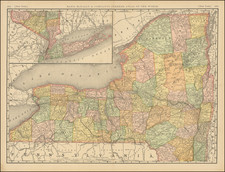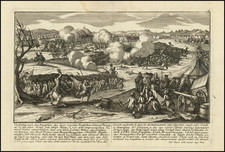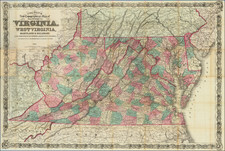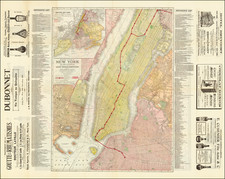This is a fabulous fragmentary taken from a book known as "the foundation of England's knowledge of America during the early period of colonization." (PMM) This small map originally occupied a portion of the title page of John Smith's The Generall History of Virginia, New=England, and the Summer Isles. . ..
The map is clearly indicated as a decorative and not an instructive work. In some ways because of this, the map becomes easier to read. The map is oriented with east at the top, so that the coastline runs along the bottom of the work. The map starts at Cape Fear, in southernmost North Carolina, before passing through "Ould Virginia" and Cape Henry. The Chesapeake is clearly visible here, with the James River leading into the interior of the continent. To the north, the cap cuts out near Cape Cod, and the mouth of the Hudson River, with Manhatten and Long Island, may be divined.
The map contains intriguing political implications. Burden notes the placement of the portraits relative to American lands. Queen Elizabeth I is portrayed over "Ould Virginia," which was where her protege Walter Raleigh located his failed settlement. To the north, we find the portrait of King James I, the namesake of Jamestown. The complete title page includes a portrait of Charles I, shown over New England where his name was bestowed on many features. The inland areas are marked Virginia Now [Planted], juxtaposing it as the Current Virginia.
John Smith's The Generall Historie of Virginia, first published in 1624, is one of the most important books regarding the early American colonial era. Written by a renowned leader of English colonization, John Smith is widely recognized as one of the founding fathers of Virginia. While some of his true deeds and intentions have been obscured by centuries of mythologization, his books provide an interesting insight into his time in the New World. While these include some very obvious self-promotion, the work is notable in that it does not attempt to oversell life in the colonies. It paints the difficulties of the area reasonably and does not tell baseless stories about endless gold and fortune. As such, they exemplify Smith's motto "he who works not, eats not."












![[Amherst County Survey of 200 Acres Owned by Captain James Dillard dated 16, 1822]](https://storage.googleapis.com/raremaps/img/small/73745.jpg)

![[ North Carolina ] Neueste Karte von Nord Carolina mit seinen Canaelen, Strassen, Eisenbahnen, Entfernung . . . .1845](https://storage.googleapis.com/raremaps/img/small/89079.jpg)